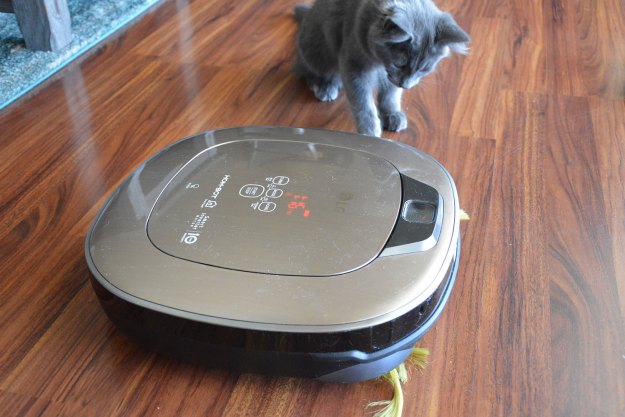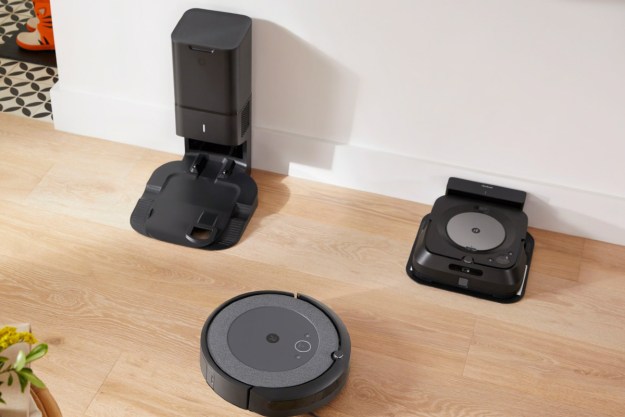
“The LG Hom-Bot Turbo+ makes an app-controlled robot vacuum fun and functional, but very pricey.”
- App has some really useful functions
- Quiet
- Potential for security camera use
- Has good battery life in normal mode
- Expensive
- Side brushes get caught on things
- Turbo function is much more effective than normal mode
Just by looking at the LG Hom-Bot Turbo+, you might not think much has changed from the previous iterations, like the VR65704LVM. The champagne color is new, but it’s what inside that counts. The robot vacuum comes with a remote so you can send it around your living room, but you can also ditch the piece of plastic for app control. The Wi-Fi enabled vac puts you in the driver’s seat, so you can actually check out your entire home while at work. LG touted it as a security camera on wheels, but our LG Hom-Bot Turbo+ CR5765GD review examines just how well it cleans up when it’s not chasing criminals (or pets) through your house.
Going for a spin
Much like its predecessors, the LG Hom-Bot Turbo+ has a square body with rounded corners and is still 3.5 inches high. Press down on the top, and it pops up to reveal a 0.6-liter dust bin with a little brush nestled in the lid to help de-gunk it. It has a display that shows the time and cleaning mode, as well as buttons for start/stop, home, mode, and turbo. Two cameras, one front-facing and the other pointing at the ceiling, help the Hom-Bot get its bearings. Underneath there’s a roller brush and spinning side brushes that help sweep debris toward the vacuum’s suction. For floors, a cloth attachment snaps on to pick up dust. The accompanying remote lets you set the time, pick the cleaning mode, and actually drive the robot around with the directional buttons. All of this is very similar to LG’s older models, but the Turbo+ adds Wi-Fi.
Yes, that means an app. You can start cleaning from work! But because the iOS and Android apps also let you control the bot, you can also treat it as a security camera on wheels. In Home Guard mode, it sends alerts when it detects motion and starts taking a series of pictures of your cat (most likely). The app also lets you schedule daily cleaning. If you think that’s too often, you’re out of luck, as you can’t set it to only run Mondays, Wednesdays, and Saturdays, for example.
In addition to the dust cloth attachment, the Hom-Bot comes with a charging station, a two-sided comb to help detangle the roller brush, a brush designed for pet fur, a magnetic strip that keeps the vac from wandering into areas you don’t want it to go, a spare filter, and extra side brushes.
A la modes
With seven cleaning modes, there are lots of ways to put this vacuum to work. Zigzag is the default, but it’s designed to be quick and dirty — as in, not especially thorough. Cell-by-cell is methodical and battery-draining. Spiral is for spot cleaning and leaves your carpet imprinted with crop circles. Repeat exhausts the bot and doesn’t even return it to the dock for charging. Turbo ups the suctions and reduces battery life. Using the remote, my space lets you map out a 3-foot section for the vacuum to focus on. When we ran it in normal mode, it would last for about 100 minutes; turbo mode drained the battery in about half that. It takes three hours to fully recharge.
Turbo mode is so much more effective than regular, but it drains the battery.
Manual mode — using the remote — seems better for getting the Hom-Bot from place to place rather than cleaning. If there’s a specific area you want to focus on, it’s better to use my space or spot mode, which lasts about five minutes. It seems to clean the designated area exhaustively. (We gave up timing at eight minutes.) In terms of cleaning performance, we found turbo kicked up performance by about 20 percent, picking up about 92 percent of debris on carpet using the spiral mode. On hardwood, normal mode scooped up 67.5 percent of the rice we spilled. Its side brushes helped corral some of the pieces into the vacuum’s path, but the bot also shot some far and wide of the spiral mode’s reach. Even without the special pet hair brush, the Hom-Bot did really well with fur. We ran it after a competing robot vacuum did a cycle on carpeted floors and found it picked up quite a bit the other missed. The included comb is marginally helpful for cleaning out the roller brush, but it’s a similar process with every other vacuum with that type of roller.
On the charts
Some robot vacuums don’t know their limits. They’ll try to climb over anything and everything. We found this to be true with the Hom-Bot. It tried to enter the closet door by scaling the sliding door’s track. It was fairly good at extracting itself from these messes. However, the spinning brushes posed a hazard: They got tangled around cat toys and even the thick carpet at one point. That’s when the Hom-Bot’s robotic voice would inform us there was an issue. It’s a nice feature, so you instantly know something’s caught on a specific wheel instead of having to search for an error code. The same voice also lets you know when the robot is charging, so there’s no doubt you’ve placed it on the dock correctly.
Where you place the dock is important. The robot has trouble docking itself if the charging station is on carpet. When it gets too far from home, it seems to wander lonely as a cloud en route back the dock. Its sensors do a good job of keeping it from bumping into walls, but it did push our bar stools back and forth a bit when it ran into the legs. However, Hom-Bot senses when it’s on carpet versus hard flooring and adjusts suction accordingly.
The Hom-Bot is pretty good at extracting itself when stuck.
Even if you don’t think you’ll use the app, the history feature is appealing. It shows a map of the vacuum’s last 20 cleans, and you’ll see exactly where it did and didn’t hit. Sometimes it’s because there’s a dresser in the way, but we also noticed some patches on our map in obstacle-less areas. They were few and far between, though. At CES 2016, LG announced the new version of the Hom-Bot would have an augmented-reality feature that would let you select a spot on a map to send the vacuum there, but that’s not available on this model.
If you don’t want the Hom-Bot to vacuum a specific rug or run into your pet’s water bowl, you can use the included magnetic wire to cordon off the section. While it seemed to work OK, LG suggests affixing it permanently so the vacuum doesn’t drag it along. We can’t see many people wanting the thick, black wire living on their kitchen floor.
If you want to drive the bot via the app, you’ll have to click on the camera icon. It takes you to the view from the Hom-Bot’s front-facing camera. You can pivot the camera left or right, then push the forward button. It lacks the maneuverability of the remote, which also lets you move the vacuum backwards. The left and right buttons on the remote turn it by fewer degrees than some others we’ve seen, giving you greater control over where the vac is headed.
The Home Guard offers the same drawbacks as a lot of DIY home security cameras, in that it sends out a lot of alerts. You can’t seem to turn the motion sensitivity up or down, either. You’ll have to turn this mode off, too, if you do want to move the vacuum to a new area. Though it’s supposed to head to a designated spot each time you turn Home Guard on, we found it could end up off by a foot or so. Also, it will only remain in this mode as long as the battery holds out. When it’s charging, the camera faces the dock, so your view is of black plastic.
While we got motion notifications in Home Guard mode, the vacuum didn’t send distress signals to the app during cleaning. This seems like a missed opportunity, especially since you can help maneuver it if it gets stuck. It might not be all that useful if you’re at the store and the spinning brush is caught on something, but at least you’d know not to expect a clean floor when you return. There also doesn’t seem to be an alert, either from the app or the bot, when the dust bin is full. It does tell you to clean it after each run, but otherwise you have to eyeball it.
Warranty
LG offers a one-year warranty for the Hom-Bot Turbo+.
Our Take
At about $1,000, the LG Hom-Bot Turbo+ is one pricey robot. It’s $100 more than the VR65704LVM was when it debuted, but the Wi-Fi capability is a pretty big change over the earlier model. While the app adds some cool features and its mobile security camera is fun (and maybe even functional), its cleaning power wasn’t so jaw-dropping that we’d spend a grand on a robot vac.
What are the alternatives?
For essentially the same price ($1,000), you can get the Dyson 360 robot vacuum. It has a ton of features, but its height (4.72 inches) means it won’t fit under a lot of furniture. If you really want a connected vacuum, the Samsung Powerbot is $600, but it doesn’t have let you control it via app the way the LG Hom-Bot does. The $900 Roomba 980 has Alexa capability, if using the app is too much of a hassle. For a somewhat lower-priced option, the Neato Botvac Connected is mere $699.
How long will it last?
Given its affinity for this design, the next LG Hom-Bot vacuum will probably look much like this one. It’s nice that they give you some spare parts, like replacement side brushes, because they do tend to get tangled up in things. There are some features we’d like to see LG bring to the app, like more scheduling flexibility, but this obviously doesn’t take a new vacuum, just an update. Considering it costs as much as a major appliance, we hope the Hom-Bot is in it for the long haul, but the warranty is only for a year.
Should you buy it?
No. Making the Hom-Bot smart added $100 to an already expensive robot vacuum. Its app has some of the best features, but if you can live without them, you can find vacs that will clean your house for far less.
Editors' Recommendations
- Best vacuum deals: Cordless to corded, Dyson to Bissell
- Ecovacs Deebot X2 Combo vs. Ecovacs Deebot X2 Omni: what’s new on the X2 Combo?
- Roborock S8 MaxV Ultra vs. Narwal Freo X Ultra: Which is the best premium robot vacuum?
- Narwal’s Freo X Ultra honors reliable, maintenance-free cleaning for 7 weeks
- The 7 best vacuums for pet hair from Dyson, Shark, and more








